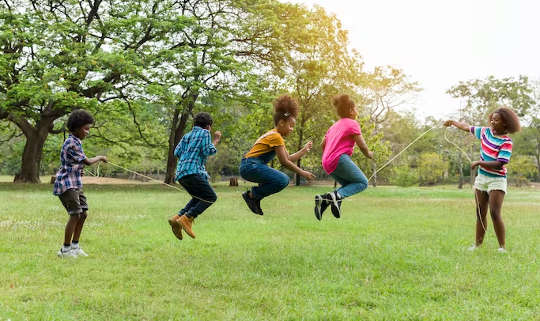
Regular physical activity helps to prevent and manage many chronic diseases. Amorn Suriyan/Shutterstock
Physical inactivity is the fourth leading cause of death worldwide. It’s also associated with chronic illness and disability. Recent research estimates that the world could see close to half a billion new cases of major chronic diseases by 2030 if people don’t get more active. Regular physical activity helps to prevent and manage many chronic diseases. Popular ways to be physically active include walking, cycling, and playing sports.
The World Health Organization (WHO) recommends that children and adolescents (5-17 years old) get an average of at least 60 minutes per day of moderate to vigorous intensity physical activity. This should incorporate vigorous aerobic activities, as well as those that strengthen muscle and bone, at least three days a week. It’s also recommended that children spend no more than two hours a day on recreational screen time. These recommendations aim to improve children’s physical and mental health, as well as cognitive outcomes.
Before the COVID-19 pandemic, physical activity among children and adolescents was already below the recommended levels. In 2016, 81% of adolescents around the world aged 11-17 were considered physically inactive. Girls were less active than boys.
The pandemic has made matters worse. Physical inactivity in children and adolescents has become a global public health priority. It is now included in global action plans.
Get The Latest By Email
For example, using 2016 as baseline, the WHO through its Global Action Plan on Physical Activity targeted a 15 percentage point reduction in prevalence of physical inactivity among adolescents by 2030. This call to action also implored other international organisations and governments to help track progress in physical activity promotion among children and adolescents.
In response to this global physical inactivity crisis, the international call to action, and the need to systematically collect comparable data, the Active Healthy Kids Global Alliance recently published a major study, the first to provide a comprehensive assessment of physical activity among children and adolescents. Published in October 2022, the study included data that were collected before and during the COVID-19 pandemic. We were among the 682 experts who assessed 10 common physical activity indicators for children and adolescents around the world.
Our study shows physical activity among children and adolescents has not gotten better. About one-third of children and adolescents globally were sufficiently physically active while a little over one-third met the recreational screen time recommendation for better health and well being. These findings indicate that a significant proportion of children and adolescent who do not meet recommended physical activity guidelines are at an increased risk of negative outcomes as well as developing related chronic diseases at a much earlier age.
COVID effect
Most of the experts involved in our study agree that the childhood physical inactivity crisis is an ongoing public health challenge and the COVID-19 pandemic appears to have made it worse. When surveyed, more than 90% of the experts reported that COVID-19 had a negative impact on children’s sedentary behaviours, organised sport and physical activity. Our findings are supported by numerous studies.
Lockdowns imposed at the height of the COVID-19 pandemic led to school shutdowns and closures of public parks, which hampered children’s levels of physical activity. Research suggests that children’s moderate-to-vigorous physical activity decreased by 17 minutes per day during the pandemic. That represents a reduction of almost one-third of the recommended daily activity. Another global study representing 187 countries showed a collective 27.3% decrease in the daily step counts of individuals after 30 days of COVID-19 related restrictions.
Our study
Four African countries participated in our study –Botswana, Ethiopia, South Africa and Zimbabwe.
The grading ranged from as high as A+ (large majority, 94%-100% of children and adolescents achieving recommended levels) to as low as F (less than 20% achieving recommended levels).
Children and adolescents from the four African countries were marginally more physically active than children from the rest of the world. They received C- (47%–53% of them met recommendations) for overall physical activity compared to the D (27%–33% met recommendations) for the rest of the world. More children and adolescents from the African countries used active transport (B-; 60%–66%), were less sedentary (C-; 40%–46%) and were more physically fit (C+; 54%–59%), compared to the rest of the world (C-, D+ and C-) respectively.
An important success story from this global comparison of grades is that despite the lack of infrastructure, average grades for individual behaviours were generally better for the African countries. This could be reflecting necessity, rather than choice. For example, children might be forced to walk to school because there’s no affordable transport. Nonetheless it shows that it is still possible to promote healthy lifestyles even when resources are limited.
Factors such as having supportive family and friends, safer communities, positive school environments and adequate resources are often associated with better participation in physical activity. Average grades for these sources of influence were generally lower for the four African countries than those of the rest of the world. These findings demonstrate the challenges related to community safety, a general lack of infrastructure, and funding to support healthy behaviours for children and adolescents in African countries.
Overall, there wasn’t enough data to accurately grade all the indicators for the African countries. Botswana was the only country for which we were able to assign grades for each of the 10 common indicators. The other three countries had at least one incomplete grade each. Lack of representative data is a common and often recurring problem in many low- and middle-income countries. It also means that our findings must be interpreted with caution. For example, we can’t say with certainty that these findings are representative of all the children and adolescents from these four countries or the region as a whole.
Way forward
In many parts of Africa, the prevalence of infectious and other diseases justifiably demands attention and resources. These needs can out compete the messages about physical inactivity, whose negative impact may be silent but still detrimental to population health.
We need to persistently advocate for policies and practices, anchored in the African context, and promote equitable opportunities for children to engage in physical activity. These can include active school recesses and extracurricular programmes. Countries need to ensure access to safe, free public spaces, green spaces, playgrounds and sporting facilities.
Finally, researchers and public health practitioners must track the progress towards meeting the WHO’s targets.
About the Authors
![]()
Taru Manyanga, Assistant Professor-Physical Therapy, University of Northern British Columbia; Chalchisa Abdeta, PhD candidate, University of Wollongong; Dawn Tladi, Senior Lecturer of Exercise Physiology, University of Botswana, and Rowena Naidoo, Associate Professor in Sport Science, University of KwaZulu-Natal
This article is republished from The Conversation under a Creative Commons license. Read the original article.
books_exercise







